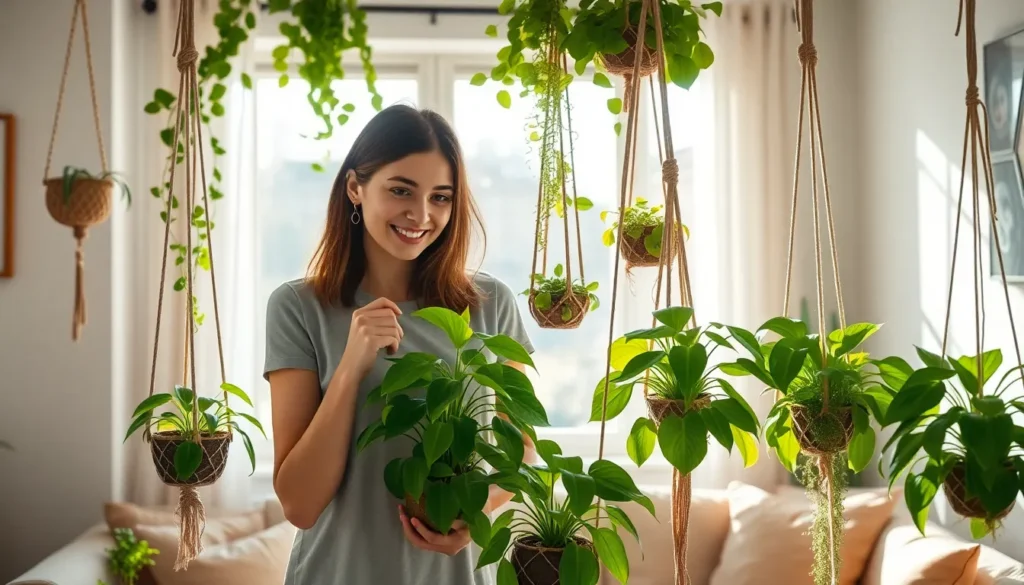We’ve all walked into a room and felt something was missing – that perfect finishing touch that transforms a space from ordinary to extraordinary. Hanging plants might just be the secret weapon your home’s been waiting for. These living decorations don’t just fill empty corners; they create vertical gardens that breathe life into any room while maximizing your floor space.
Transform your living space into a lush sanctuary without sacrificing precious square footage. We’ll show you how strategic placement of hanging plants can dramatically improve your home’s air quality while adding that Instagram-worthy aesthetic you’ve been craving. From low-maintenance succulents to cascading pothos, there’s a perfect hanging plant for every room and skill level.
Ready to discover which plants thrive in hanging baskets and where to position them for maximum impact? We’re about to jump into everything you need to know about creating stunning vertical displays that’ll have your guests asking for your secret.
Choose the Right Hanging Plants for Your Room’s Lighting Conditions
Selecting hanging plants that match your room’s natural light levels ensures healthy growth and vibrant foliage. We’ll guide you through the best options for every lighting situation.
Low-Light Hanging Plants for Darker Spaces
Pothos varieties thrive in dimly lit corners and require minimal maintenance. These trailing beauties like Golden Pothos and Marble Queen adapt well to low light conditions found in bathrooms, bedrooms, and interior hallways. We recommend placing them 6-8 feet from north-facing windows for optimal growth.
ZZ plants create stunning cascading displays in spaces with limited natural light. Their glossy, dark green leaves reflect available light and can survive in areas that receive only artificial lighting. These hardy specimens need watering just once every 2-3 weeks.
Philodendrons flourish in shadowy environments while producing long, elegant vines. Heartleaf Philodendron and Brasil varieties tolerate fluorescent office lighting and dim living spaces. We’ve seen these plants grow up to 4 feet in length when properly cared for in low light conditions.
Snake plants offer vertical interest in hanging planters for dark rooms. Their upright, sword-like leaves create dramatic silhouettes and can handle almost complete shade. These plants purify air while requiring water only once monthly.
Bright Light Hanging Plants for Sunny Rooms
String of Pearls creates eye-catching displays in south-facing windows and sunrooms. These succulent trailing plants need 6-8 hours of direct sunlight daily to maintain their plump, bead-like appearance. We suggest rotating them weekly to ensure even growth on all sides.
Boston Ferns develop lush, full fronds when positioned in bright, filtered light. They prefer morning sun and afternoon shade, making east-facing windows ideal spots. These plants require consistent moisture and humidity levels above 50%.
Spider plants produce abundant baby plantlets in bright, indirect sunlight. Their arching green and white striped leaves create beautiful cascading effects in sunny kitchens and living rooms. We recommend keeping soil consistently moist during growing season.
English Ivy grows rapidly in bright light conditions and creates dense, flowing coverage. This versatile climber adapts to both direct and indirect bright light while producing oxygen-rich foliage. Regular pruning keeps growth manageable and promotes fuller appearance.
Medium Light Hanging Plants for Versatile Placement
Prayer plants showcase colorful foliage patterns in moderate light conditions throughout your home. Maranta and Calathea varieties display striking leaf markings and fold their leaves at night. We position these plants 3-4 feet from east or west-facing windows.
Tradescantia varieties offer vibrant purple, pink, and silver trailing stems in medium light. Commonly called inch plants or wandering jew, they grow quickly and root easily in water. These plants prefer consistent moisture and temperatures between 65-75°F.
Monstera Deliciosa creates dramatic split-leaf displays in bright, indirect light. Young plants trail beautifully from hanging baskets before developing their characteristic fenestrations. We recommend providing moss poles for support as they mature.
Hoya plants produce waxy, fragrant flowers when grown in medium to bright indirect light. Their thick, succulent-like leaves store water efficiently, requiring less frequent watering than most hanging plants. These slow-growing specimens can live for decades with proper care.
Select the Perfect Hanging Planters and Containers
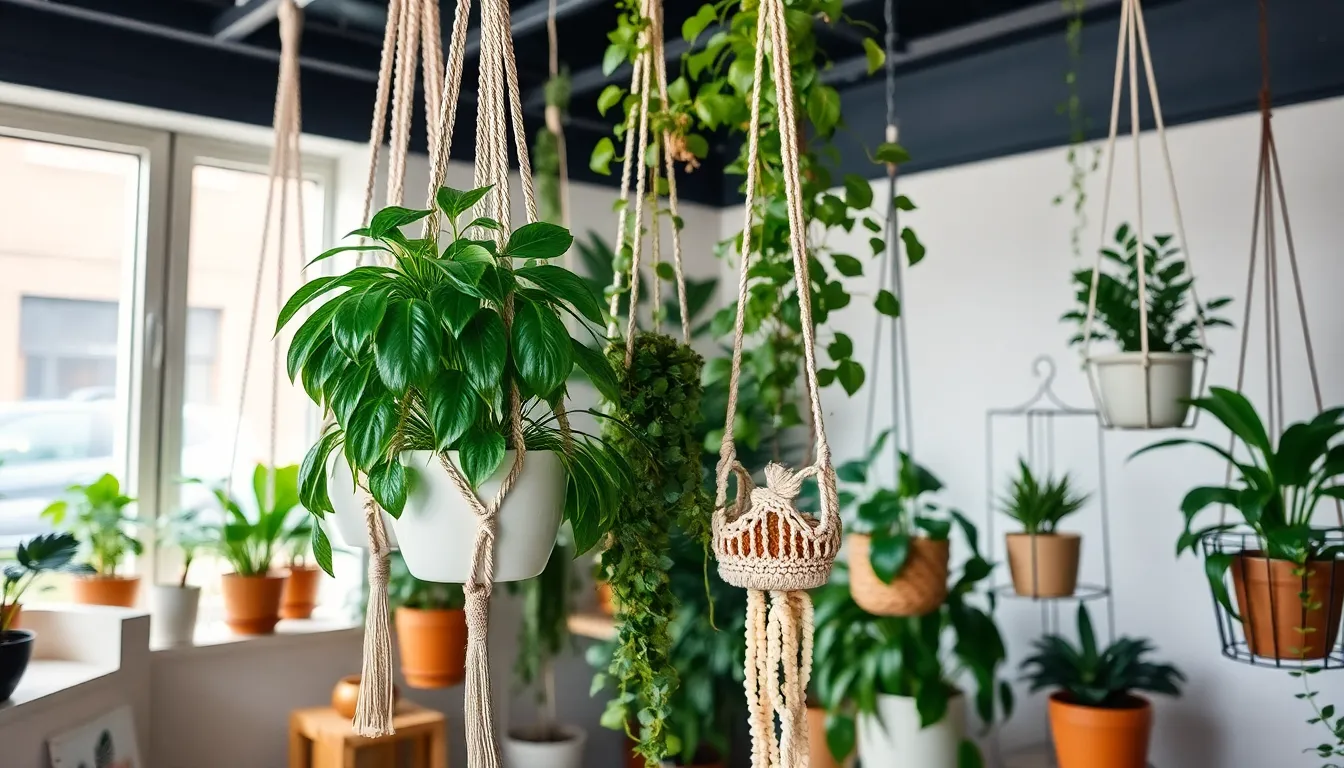
Now that we’ve chosen our ideal hanging plants for different lighting conditions, we need the right containers to showcase them beautifully. The perfect planter combines functionality with style while ensuring our plants thrive in their elevated positions.
Macrame Plant Hangers for Bohemian Style
Macrame hangers transform any room into a boho paradise with their handcrafted knotted cord designs. These lightweight decorative holders work perfectly for small to medium plant pots and add incredible texture and artisanal charm to our spaces. We love how they enhance the visual flow of trailing plants like Pothos and String of Pearls.
Choosing macrame hangers means embracing rustic interiors that feel both relaxed and sophisticated. They’re incredibly versatile and complement natural materials like wood and rattan throughout our homes. The intricate knotwork creates beautiful shadows on walls when light filters through, adding another layer of visual interest to our vertical garden displays.
Ceramic and Terracotta Hanging Pots
Ceramic and terracotta pots offer timeless appeal that works with virtually any decor style we choose. Terracotta’s porous nature allows excellent air circulation to plant roots, though we’ll need to water more frequently since these containers dry out faster than other materials. This natural breathing quality makes them perfect for plants that prefer well-draining soil.
Ceramic options come in countless colors and finishes that complement both modern and traditional interiors beautifully. We can find everything from glossy white minimalist designs to richly glazed colorful pieces that become statement features. Both materials handle moderate weight plants exceptionally well and provide the stability our hanging gardens need to flourish.
Modern Metal and Wire Plant Holders
Metal and wire holders deliver sleek sophistication that perfectly suits minimalist, industrial, or contemporary decor styles. These durable options support heavier plants effortlessly while maintaining clean geometric lines that add architectural interest to our spaces. We appreciate how their strength allows us to display larger specimens that might overwhelm other hanging systems.
Wire holders often feature innovative designs with geometric patterns or clean lines that create stunning visual focal points. The metallic finishes reflect light beautifully and can coordinate with existing hardware throughout our rooms. These holders work especially well in modern kitchens, bathrooms, and living areas where their streamlined aesthetic enhances the overall design scheme.
Determine the Best Locations for Hanging Plants in Room Spaces
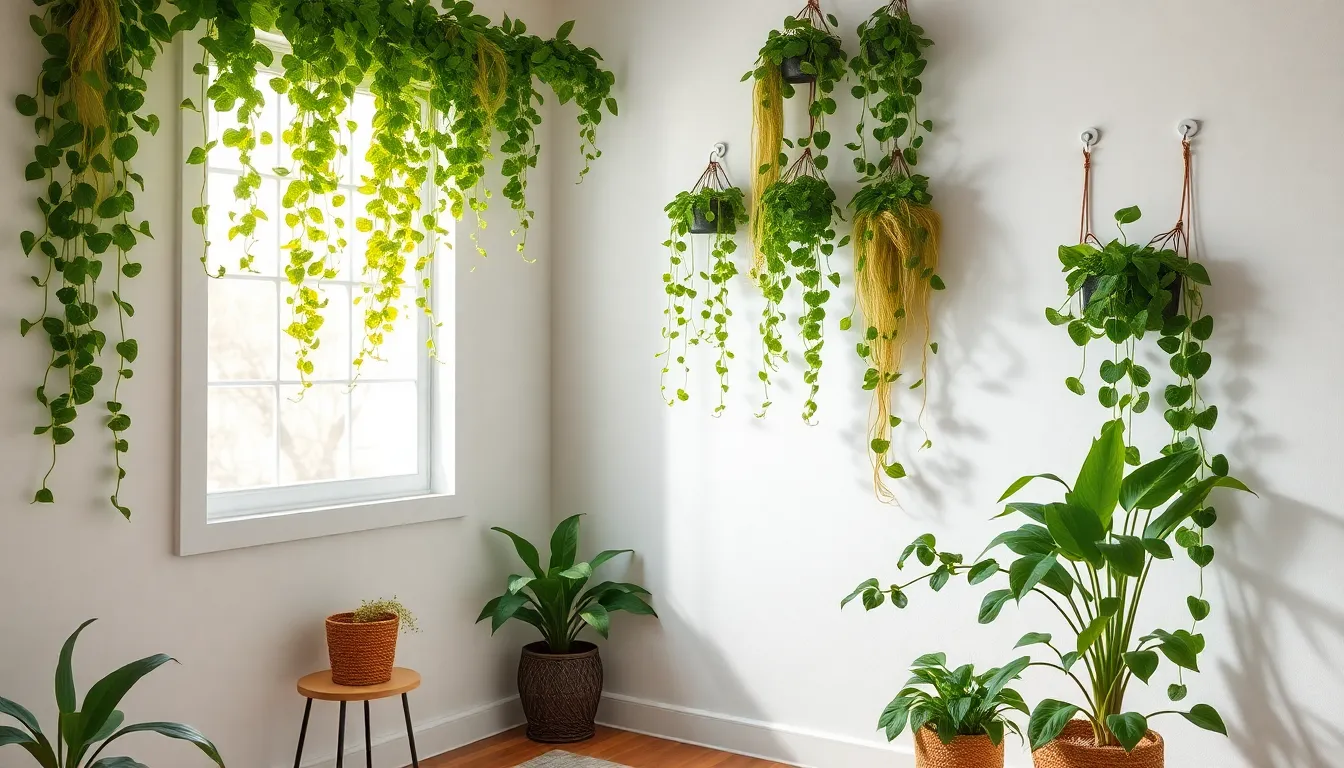
Finding the perfect spots for your hanging plants transforms any room into a lush, green sanctuary. We’ll explore strategic placement options that maximize both plant health and visual impact.
Corner Hanging Plants to Maximize Floor Space
Corners offer the most underutilized real estate in our homes for hanging plant displays. These forgotten spaces become instant focal points when we suspend trailing plants like Pothos or Spider plants from ceiling hooks or wall brackets. Floor space remains completely free for furniture and foot traffic while creating vertical interest that draws the eye upward.
We recommend using sturdy wall-mounted hooks positioned 6-12 inches from corner walls to allow plants room to cascade naturally. Trailing varieties work exceptionally well in corners since they won’t obstruct pathways or furniture placement. Multi-level corner installations using different hook heights create layered greenery that transforms dead space into living art.
Window Hanging Plants for Natural Light
Windows provide the ideal combination of natural light and display space for hanging plants. Southern-facing windows offer full sunlight perfect for sun-loving varieties like String of Pearls and Boston Ferns. East and west-facing windows deliver bright, indirect light that suits most hanging plants without risking leaf burn.
We position plants 12-18 inches from window glass to prevent temperature fluctuations while maximizing light exposure. Suction cup planters attached directly to windows create floating garden effects that don’t require ceiling modifications. Grouping multiple hanging plants at varying heights near windows forms natural privacy screens while ensuring each plant receives adequate light.
Ceiling-Mounted Plants for Dramatic Effect
Ceiling installations create the most striking visual impact by emphasizing room height and adding architectural interest. We mount plants from ceiling beams or use heavy-duty ceiling hooks rated for at least 50 pounds to support larger specimens and their water weight. Single statement plants work beautifully in rooms with high ceilings, while multi-tier arrangements suit standard 8-foot heights.
Dramatic ceiling displays work best with plants that have interesting shapes or cascading growth habits like Monstera Deliciosa or trailing Philodendrons. We position ceiling-mounted plants away from high-traffic areas to prevent accidental contact and ensure adequate clearance for plant growth and maintenance access.
Install Proper Hanging Hardware and Support Systems
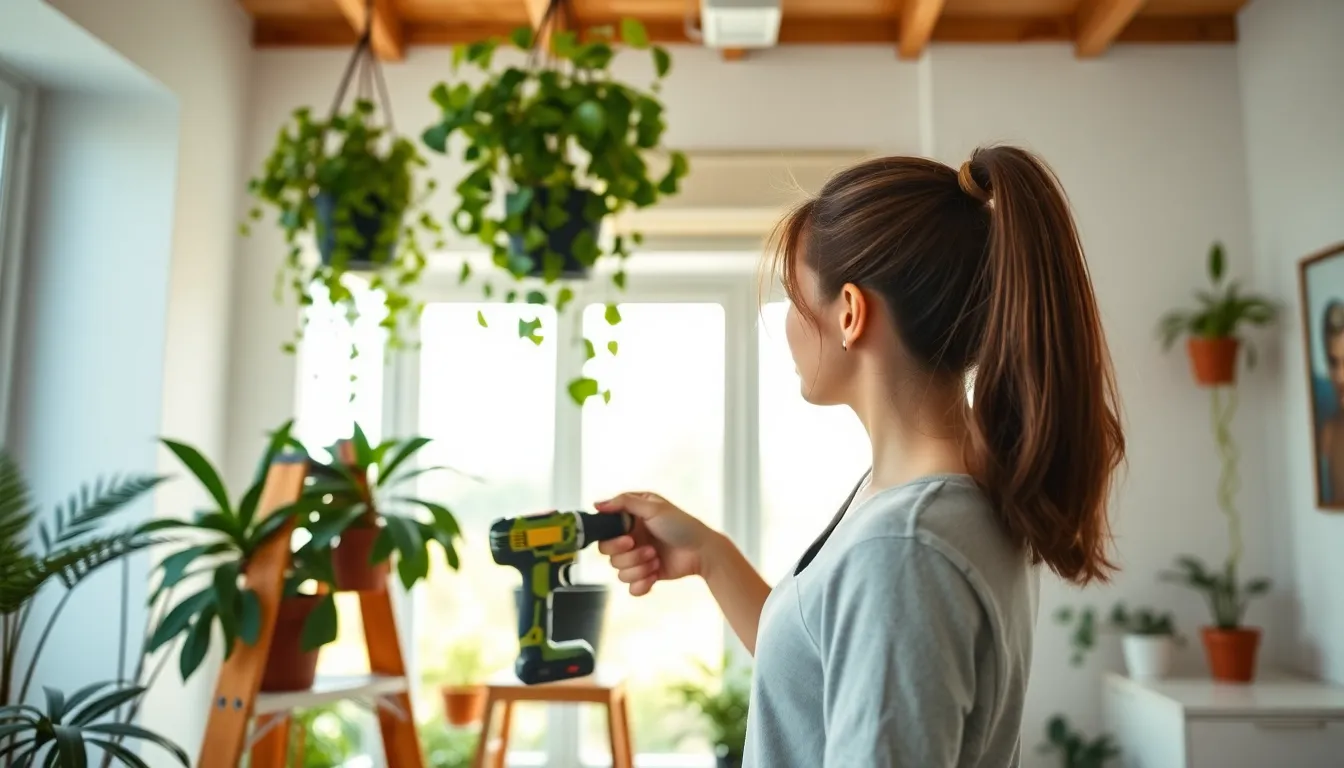
We need to select the right hardware based on our plant’s weight, ceiling type, and whether we can make permanent modifications to our space. Proper installation ensures our hanging plants remain secure while protecting both our plants and our home.
Ceiling Hooks and Anchors for Heavy Plants
Hook screws into ceiling joists provide the strongest support for plants weighing 30+ pounds. We use a stud finder to locate ceiling joists, drill a pilot hole smaller than the screw diameter, and secure the hook flush with the ceiling surface. This method offers maximum weight capacity and long-term stability.
Swag hooks with toggle bolts work perfectly for drywall ceilings supporting plants up to 15-20 pounds. We drill a 5/8-inch hole, insert the toggle bolts with attached hooks, and tighten them for secure hold. These anchors distribute weight across a larger drywall area, preventing damage while maintaining strong support.
We should always test hook strength before hanging valuable plants by pulling firmly on empty planters first. This simple check prevents accidents and ensures our installation can handle the full weight of soil, water, and mature plant growth.
Wall-Mounted Brackets for Side Hanging
Wall-mounted brackets offer excellent alternatives when ceiling installation isn’t possible or practical. We anchor these brackets directly into wall studs or use heavy-duty wall anchors for drywall mounting. Side-hanging arrangements work particularly well in narrow spaces, hallways, or rooms with low ceilings.
These mounting systems distribute plant weight horizontally rather than vertically, reducing stress on ceiling structures. We position brackets at comfortable heights for plant care while ensuring adequate clearance for plant growth and daily activities.
Pulley Systems for Easy Plant Maintenance
Pulley systems transform plant care by allowing us to lower hanging plants for watering and maintenance without climbing ladders. We attach pulleys to our ceiling hooks and use rope systems to raise or lower plants as needed. This convenience reduces strain on our backs and minimizes the risk of dropping plants during care routines.
These systems work especially well for plants requiring frequent attention or those hanging at important heights. We can easily adjust plant positions for optimal light exposure throughout seasons while maintaining safe access for pruning, repotting, and general maintenance tasks.
Master the Art of Watering Hanging Plants Indoors
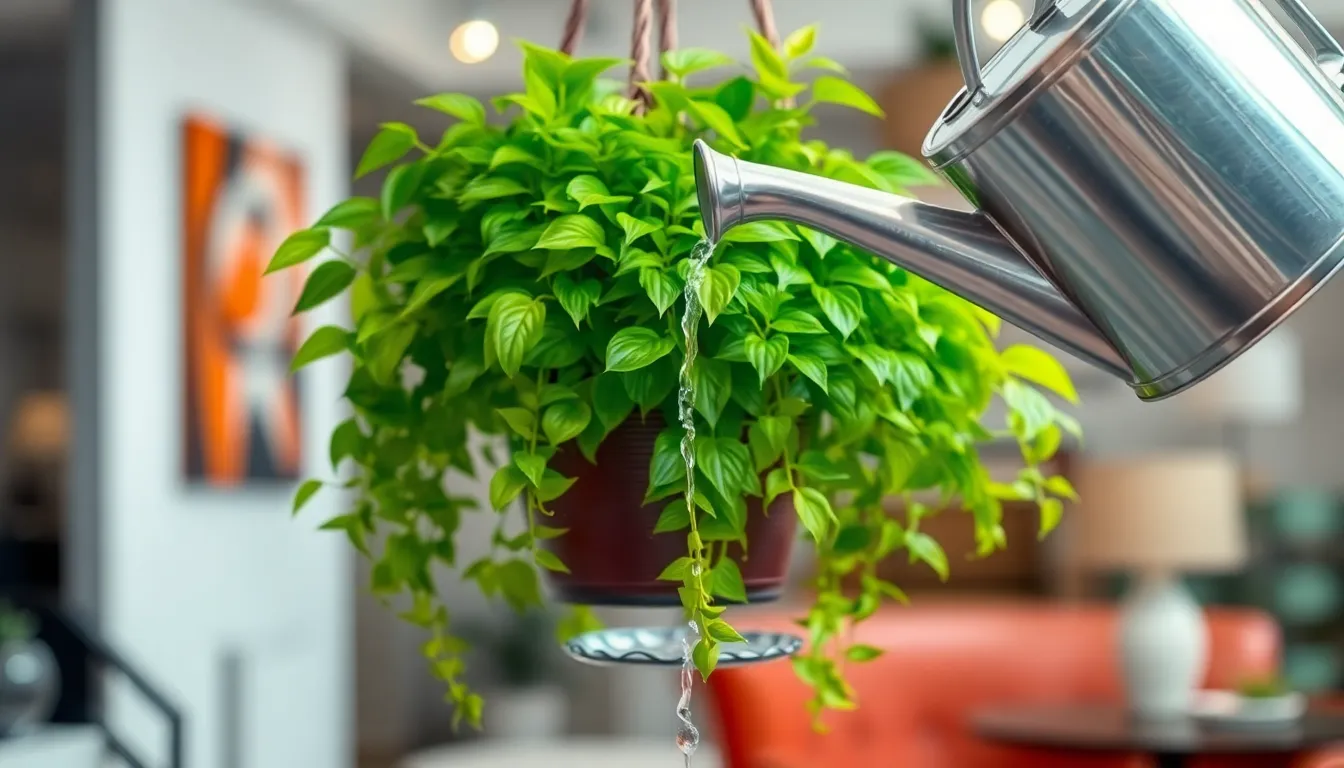
Watering hanging plants presents unique challenges that require strategic approaches to maintain healthy plants while protecting our indoor spaces. We’ll explore proven techniques to keep our elevated greenery thriving without creating messy water damage.
Watering Techniques to Prevent Dripping
Controlled spout watering offers the most precise method for delivering water to hanging plants. We recommend using a watering can with a thin spout to apply water slowly and avoid excessive runoff that leads to dripping messes.
Strategic watering locations eliminate indoor water damage concerns entirely. We suggest moving plants to sinks or showers during watering sessions and allowing excess water to drain completely before rehanging them in their display positions.
Ice cube watering provides an innovative solution for gradual moisture delivery. Place 2-4 ice cubes directly on the soil surface, ensuring they don’t contact plant stems to prevent cold shock. Water releases slowly as ice melts, significantly reducing dripping since soil absorbs moisture gradually.
Small portion watering prevents overwhelming the soil’s absorption capacity. We apply water in measured amounts, allowing each portion to soak into the soil before adding more, which eliminates runoff completely.
Drainage Answers for Hanging Planters
Drip tray systems protect our floors and furniture from water damage effectively. We position decorative pots without drainage holes underneath hanging planters to catch excess water while maintaining aesthetic appeal.
Terracotta plate answers offer environmentally conscious drainage options. These plates feature elevated edges that prevent water overflow while providing sustainable alternatives to plastic drip trays.
Well-draining soil mixtures create the foundation for proper water management. Our recommended blend includes garden soil, cocopeat, compost, and perlite, which retains moisture while allowing excess water to drain efficiently.
Monitoring Soil Moisture in Elevated Plants
Touch testing remains the most reliable method for assessing soil moisture in hanging plants. We check soil dampness by inserting our finger about one inch deep into the soil surface before watering.
Capillary watering systems provide consistent moisture without manual monitoring. We create these systems using cut plastic bottles as water reservoirs with cotton strips extending into the soil, allowing water to move slowly through capillary action.
Optimal watering timing maximizes plant absorption and minimizes waste. Morning watering between 5 am and 9 am allows plants to absorb moisture before daily heat stress occurs, reducing the risk of overwatering and dripping issues.
Create Stunning Visual Arrangements with Multiple Hanging Plants
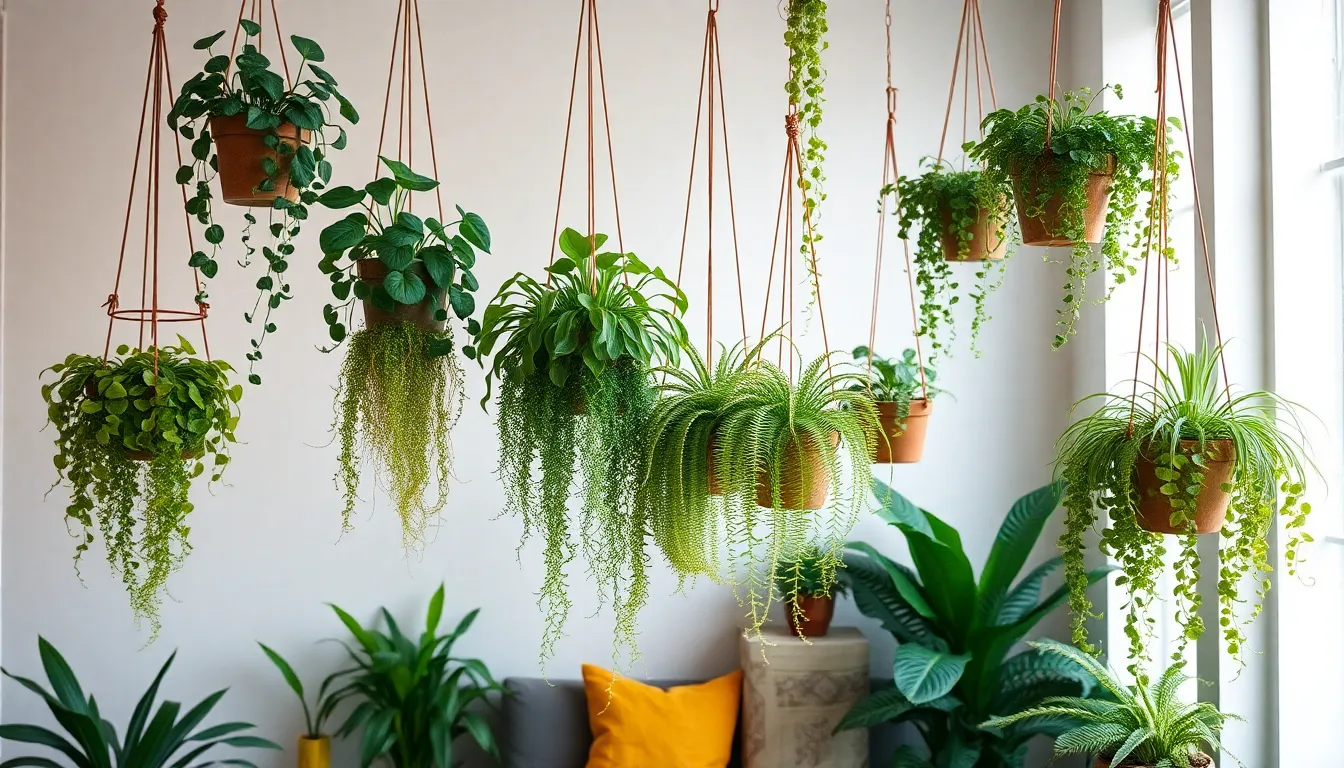
Now that we’ve covered proper installation and watering techniques, let’s explore how to design visually striking displays that transform your space into a lush indoor oasis.
Layering Plants at Different Heights
Suspending plants at varying elevations creates depth and dimension that draws the eye upward through your room. We recommend hanging baskets from ceiling hooks at different levels or using curtain rods to create cascading displays. Trailing species like pothos and philodendron work beautifully when suspended at higher points, allowing their vines to flow naturally downward at staggered heights.
Position your tallest hanging plants near the ceiling and gradually decrease heights as you move outward. This layering technique transforms unused vertical space into ever-changing green displays. Corner installations particularly benefit from this approach, as the varied heights prevent the arrangement from appearing flat or monotonous.
Combine ceiling mounted plants with wall mounted varieties to maximize your layering options. Wall planters can fill mid level spaces while ceiling hangers occupy the upper reaches, creating a full spectrum of green from floor to ceiling.
Mixing Plant Types for Textural Interest
Incorporating diverse plant species enhances visual texture and prevents your display from looking repetitive. We suggest combining trailing plants like English ivy and hoya with more compact upright varieties in smaller wall mounted containers. The contrast between cascading and structured growth patterns creates visual tension that keeps arrangements captivating.
Select plants with different leaf shapes and sizes to add complexity to your display. Heart shaped pothos leaves provide softness, while the architectural lines of snake plants or the delicate fronds of ferns offer striking contrasts. Succulents contribute geometric forms that balance the organic flow of trailing species.
Group plants with similar care requirements but different textures together for easier maintenance. This strategy allows you to water and tend multiple plants efficiently while maintaining the diverse visual appeal that makes hanging displays so captivating.
Balancing Colors and Foliage Patterns
Choose plants with complementary leaf colors and patterns to create harmony without monotony. Variegated species with green and yellow or white markings provide beautiful contrast against solid green foliage. We’ve found that this interplay of colors adds depth without overwhelming the space.
Distribute colorful and patterned plants evenly throughout your arrangement rather than clustering them together. Speckled or striped leaves work best when scattered among solid colored varieties, creating rhythm and visual flow across your entire display.
Use neutral colored pots and plant holders to highlight your plants’ natural hues. Terra cotta, white ceramics, or natural wood planters allow the foliage to take center stage while providing cohesive visual anchors throughout your arrangement. Avoid competing colors in your containers that might distract from the plants themselves.
Maintain Healthy Growth in Your Hanging Room Plants
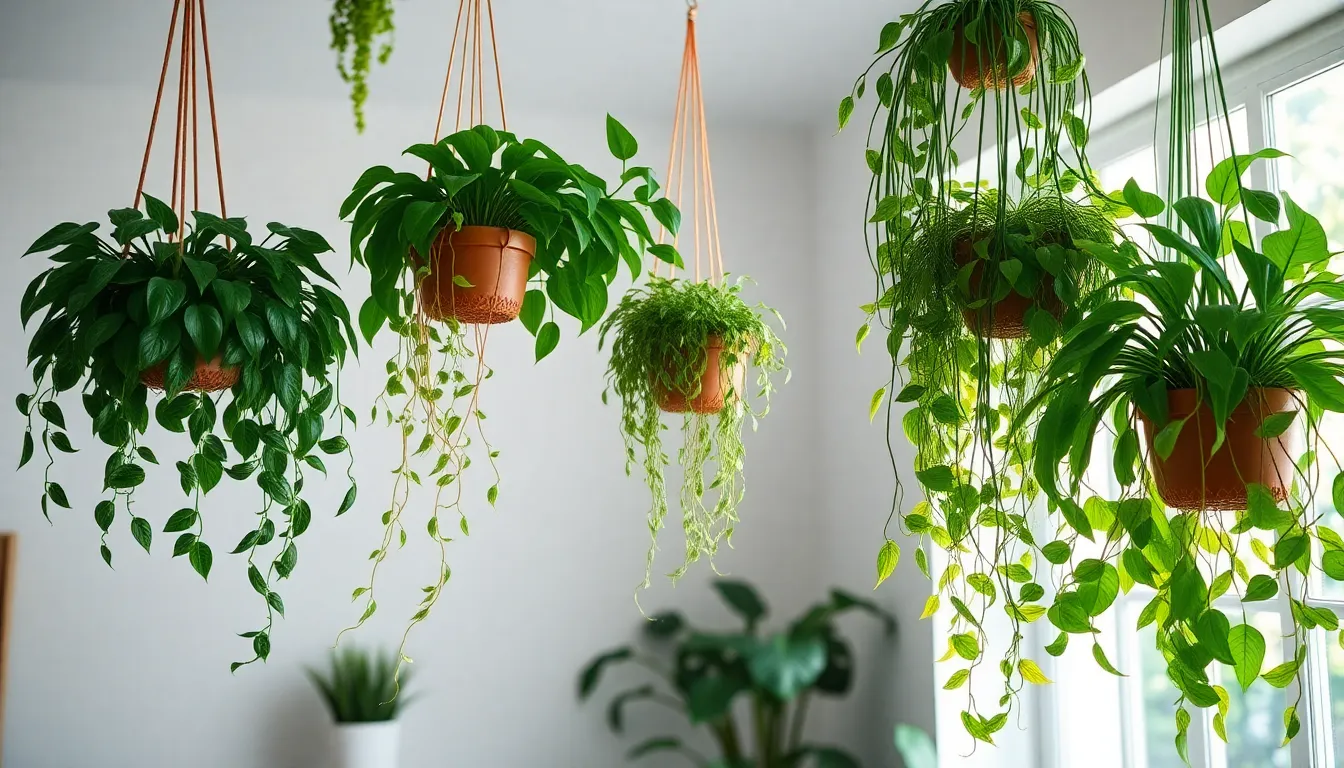
Now that we’ve established beautiful hanging displays throughout our rooms, let’s focus on the essential care practices that’ll keep our suspended plants thriving for years to come.
Pruning and Trimming Hanging Plant Varieties
Regular pruning encourages fuller bushier growth and prevents our hanging plants from becoming leggy or sparse. We should trim dead or yellow leaves promptly to maintain plant health and create an attractive appearance that enhances our room’s aesthetic.
Trailing varieties like Pothos and Spider plants benefit from periodic pinching of growing tips to promote branching. Flowering hanging plants such as Petunias require deadheading spent blooms to encourage continuous flowering throughout the growing season. We can also trim overly long vines that may obstruct walkways or interfere with our daily activities.
Sharp clean scissors or pruning shears prevent damage and disease transmission between plants. Spring typically offers the best timing for major pruning sessions when plants enter their active growing phase.
Fertilizing Suspended Plants Effectively
Feed hanging plants with balanced fertilizer during growing season typically from spring through summer to support healthy vigorous growth. We should avoid fertilizing in winter or low light periods as growth naturally slows down during these months.
Liquid fertilizers work exceptionally well for hanging plants since we can easily incorporate them into our regular watering routine. Diluted fertilizer answers prevent root burn while providing consistent nutrition that suspended plants need more frequently than ground level plants.
Hanging plants in our rooms often require more frequent feeding than traditional potted plants due to faster drainage and increased air circulation. We recommend fertilizing every 2-3 weeks during peak growing season and reducing to monthly applications as daylight hours decrease.
Slow release granular fertilizers offer convenience for busy plant parents who prefer less frequent maintenance schedules.
Rotating Plants for Even Growth
Rotate hanging plants periodically to ensure all sides receive equal light exposure preventing uneven growth or unsightly leaning toward light sources. We should turn our suspended plants a quarter turn weekly to maintain balanced symmetrical growth patterns.
Plants naturally grow toward available light creating lopsided appearances if we neglect regular rotation. Corner placements near windows particularly benefit from consistent turning since light typically comes from one primary direction.
Heavy trailing plants may require two people for safe rotation to avoid damaging stems or disturbing the hanging mechanism. We can mark our plant containers with small stickers to track rotation schedules and ensure we don’t miss any plants during weekly care routines.
Seasonal light changes in our rooms also affect growth patterns making rotation even more critical during winter months when natural light becomes limited and directional.
Troubleshoot Common Hanging Plant Problems
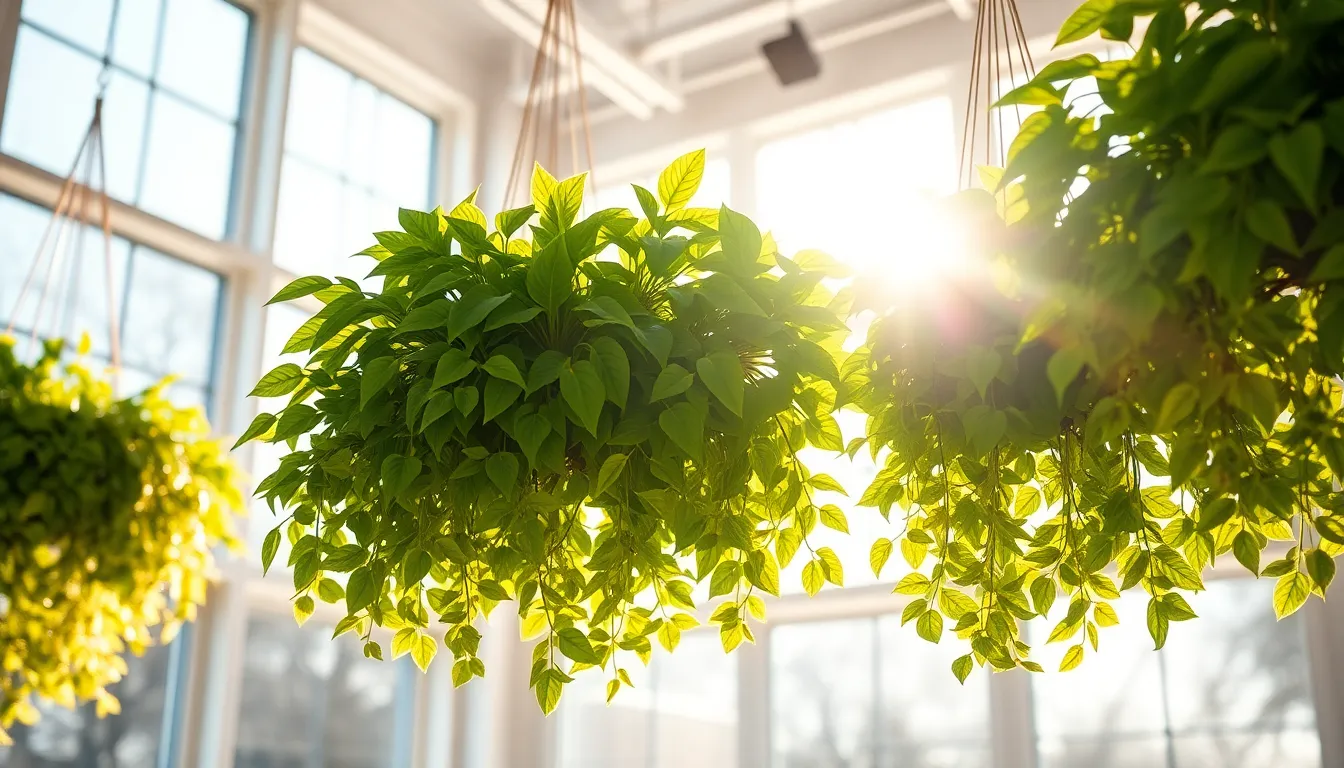
Even with proper care and maintenance, hanging plants can face unique challenges that require exact troubleshooting approaches. We’ll help you identify and resolve the most common issues to keep your elevated garden thriving.
Preventing Pest Issues in Hanging Plants
Maintain leaf cleanliness by regularly dusting leaves or gently showering plants to remove dust and potential pests. Dust accumulation creates breeding grounds for spider mites and other harmful insects that can quickly spread throughout your hanging collection.
Improve airflow around your suspended plants by spacing them adequately and using ceiling fans on low settings. Good circulation prevents stagnant air conditions that attract aphids, fungus gnats, and scale insects to your room’s vertical displays.
Monitor plants weekly for early signs of pest activity like webbing, sticky residue, or tiny moving dots on leaves. Quick detection allows us to treat infestations before they damage multiple plants or spread to neighboring hanging specimens.
Use suitable plant care products when pests appear, focusing on organic neem oil or insecticidal soap that won’t harm indoor air quality. Keeping healthy plants through proper watering and fertilization naturally reduces pest risks in hanging containers.
Addressing Yellowing or Dropping Leaves
Check soil moisture levels immediately when leaves start yellowing or dropping, as this often signals overwatering or underwatering issues. Hanging plants dry out faster than ground plants, requiring more frequent monitoring of their unique moisture needs.
Provide balanced fertilization using liquid fertilizer weekly from March to October or slow-release fertilizer twice per season to supply nutrients. Limited soil volume in hanging containers means plants quickly deplete available nutrients, leading to yellowing foliage.
Examine light conditions to ensure your hanging plants aren’t receiving too much direct sun or sitting in overly dark corners. Stress from improper lighting causes leaf drop and discoloration in suspended plants more rapidly than floor-based varieties.
Remove yellowed leaves promptly to redirect plant energy toward healthy growth and prevent potential disease spread. Trimming damaged foliage also improves the overall appearance of your hanging displays.
Managing Root-Bound Plants in Hanging Containers
Repot plants into slightly larger containers when roots circle the pot’s bottom or emerge from drainage holes. Hanging plant containers become root-bound quickly due to limited soil space, restricting nutrient uptake and water absorption.
Prune roots carefully if repotting isn’t immediately possible, removing about one-third of the root mass to encourage new growth. This technique refreshes root-bound hanging plants while maintaining their current container size for your room’s design needs.
Choose appropriately sized planters initially to prevent rapid root congestion and excessive drying. Starting with containers that provide adequate root space reduces the frequency of repotting and maintains healthier hanging plants long-term.
Monitor drainage closely in root-bound plants, as compacted roots prevent proper water flow and create soggy conditions. We recommend checking drainage holes monthly and clearing any blockages caused by dense root systems.
Conclusion
Transforming your living space with hanging plants doesn’t have to be complicated when you’ve got the right knowledge and approach. We’ve covered everything from selecting the perfect plants for your lighting conditions to mastering the art of proper installation and maintenance.
The key to success lies in understanding your space’s unique needs and matching them with suitable plants and hanging systems. Whether you’re creating a dramatic ceiling installation or a cozy corner display your attention to proper support hardware and watering techniques will ensure long-lasting beauty.
With these strategies in hand you’re ready to elevate your home’s aesthetic while enjoying the air-purifying benefits that only living greenery can provide. Your guests will definitely notice the difference that thoughtfully placed hanging plants make in creating a vibrant welcoming atmosphere.
Frequently Asked Questions
What are the best hanging plants for low-light rooms?
For low-light spaces, choose hardy plants like Pothos, ZZ plants, Philodendrons, and Snake plants. These varieties thrive with minimal light and require less frequent care, making them perfect for bathrooms, bedrooms, or rooms with limited natural light. They’re also forgiving for beginners.
How do I choose the right hanging planter for my space?
Consider your room’s style and the plant’s needs. Macrame hangers add bohemian charm and work well with trailing plants. Ceramic and terracotta pots offer timeless appeal with excellent air circulation. Modern metal holders provide sleek sophistication and can support heavier plants while complementing contemporary decor.
Where should I hang plants in my home for best results?
Strategic placement is key. Use corners for trailing plants like Pothos to create focal points without blocking pathways. Position plants near windows for natural light while avoiding temperature fluctuations. Ceiling-mounted installations create dramatic effects and enhance room height when properly secured.
How do I water hanging plants without making a mess?
Use a thin-spout watering can for controlled watering, or move plants to sinks during watering sessions. Ice cubes provide gradual moisture delivery. Install drip trays to catch excess water and ensure proper drainage with well-draining soil mixtures to prevent root rot and water damage.
What type of hardware do I need to hang plants safely?
Choose hardware based on your plant’s weight and ceiling type. Use heavy-duty ceiling hooks and anchors for substantial plants. Wall-mounted brackets work for side hanging when ceiling installation isn’t possible. Consider pulley systems for easy maintenance and height adjustments of your hanging plants.
How often should I fertilize my hanging plants?
Hanging plants typically need more frequent fertilizing due to faster drainage. Use balanced fertilizers during the growing season (spring and summer). Feed most hanging plants every 2-4 weeks during active growth periods, but reduce or stop fertilizing in winter when growth naturally slows down.
How do I prevent pests in my hanging plants?
Maintain good airflow around plants and keep leaves clean by wiping them regularly. Inspect plants weekly for signs of pests like spider mites or aphids. Ensure proper soil moisture without overwatering, as soggy conditions attract pests. Quarantine new plants before introducing them to your collection.
When should I repot my hanging plants?
Repot when plants become root-bound, typically every 1-2 years. Signs include roots growing through drainage holes, water running straight through without absorption, or stunted growth. Choose containers only slightly larger than the current pot to prevent overwatering issues and maintain proper plant proportions.

